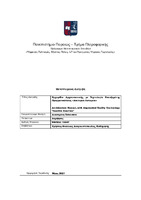Εγχειρίδιο αρχιτεκτονικής, με τεχνολογία επαυξημένης πραγματικότητας «Ανενεργά Λατομεία»
Architecture manual, with augmented reality technology "Inactive Quarries"

View/
Keywords
Αρχιτεκτονική ; Λατομεία ; Επανάχρηση ; Επαυξημένη πραγματικότητα ; Τρισδιάστατα μοντέλα ; Διάδραση ; ΕφαρμογήAbstract
The aim of the dissertation is to connect Technology with Architecture through an interactive e book, which makes possible the idea of "Interactive Architecture". The globalization of modern
economies and societies combined with the rapid pace of technology has led us to the digital
world and, therefore, the full recognition of all aspects of daily life, including architecture, is
essential. The connection of technology with the various aspects of architecture becomes
important but also now necessary. Through the digital world, especially in the difficult times we
are going through, there is the possibility of both direct and indirect contact with important
architectural events, achievements and objects. This is achieved through the creation of
"interactive architecture" through e-books, whose main purpose is the interaction and
transmission of new knowledge to those who wish to expand their intellectual horizons in the
field of architecture.
Specifically, through the following dissertation, an architecture manual with augmented
reality technology is created, which focuses, through historical background, on the utilization
and restoration of abandoned inactive quarries. The socio-political and economic fermentations
of the past centuries brought about intensive transformations in the city. A consequence of the
phenomenon was, among other things, the creation of a network consisting of urban and
territorial gaps. The obscure and unplanned unstructured spaces, for example the inactive
quarries, are treated as discontinuities of the urban fabric and while causing embarrassment are
suitable places for local, cultural and urban landscaping. At the same time, 3D models and other
types of illustrations have been created, in combination with audio material, in order to achieve
the desired interactivity of the manual.
The main goal is to create an architecture manual that will interact with its readers, will
fascinate them and will contribute to the expansion of new knowledge but also to the completion
of existing ones. For the implementation of both the book and the application, where it is a
complementary element, knowledge that I gained through my undergraduate studies as an
architect was used, but also from the postgraduate studies in digital culture.


